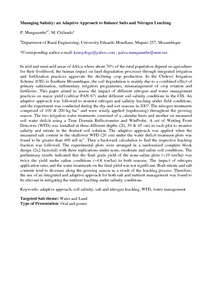Low cost animal drawn implements for Vertisol management and strategies for land use intensification
The main aim of land preparation is to modify and manipulate the land features so as to create favorable environment for seed establishment and crop growth. The research and Development in this field must take into account the traditional practices used by the farming community. This case study gives a brief description of farmers' management of Vertisols and soils with 'Vertic' properties and the Development of the low cost broad bed maker (BBM) for facilitating surface drainage.
Livestock and deforestation in Central America in the 1980s and 1990s: a policy perspective
This study analyses seven factors used to explain the conversion of forest to pasture in Central America between 1979 and 1994: 1) favourable markets for livestock products; 2) subsidised credit and road construction; 3) land-tenure policies; 4) limited technological change in livestock production; 5) policies which reduce timber values; 6) reduced levels of political violence; and 7) characteristics specific to cattle which make conversion attractive. Deforestation rates in Central America declined in the 1980s, but remained high.
Livestock, livelihood and land management issues in the highlands of Ethiopia
Managing natural forests for sustainable harvests of mahogany (Swietenia macrophylla): experiences in Mexico's community forests
In 2002, mahogany (Swietenia macrophylla) was listed on Appendix II of CITES (the Convention on International Trade in Endangered Species). This requires that all producing countries define and implement sustainable production systems for mahogany, the most commercially important neotropical timber, which is still harvested from natural forests. The only serious efforts to produce mahogany sustainably from managed natural forests are those of communities in Quintana Roo, Mexico, which control 800,000 of natural production forests.
Manual de tecnologías en la cadena agroindustrial de la yuca (Manihot esculenta Crantz)
Managing salinity: An adaptive approach to balance salts and nitrogen leaching
Managing water infrastructure and equitable land compensation schemes in irrigation projects for social and environmental benefits.
Managing smallholder teak plantations: field guide for farmers
The typical practice by smallholder teak growers of letting trees grow without management input has resulted in poor quality plantations. Various questions arise when farmers start to better manage their teak plantations. This book provides practical guidance in addressing these questions by explaining in detail the techniques of parent tree selection, seed preparation, seedling production, planting, fertilising, thinning, pruning, controlling pest and disease and harvesting. To be more easily understood, the descriptions are complemented by illustrations, photographs or tables.





